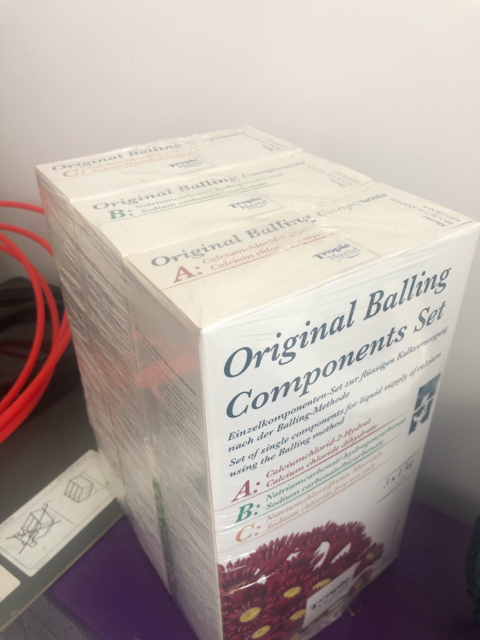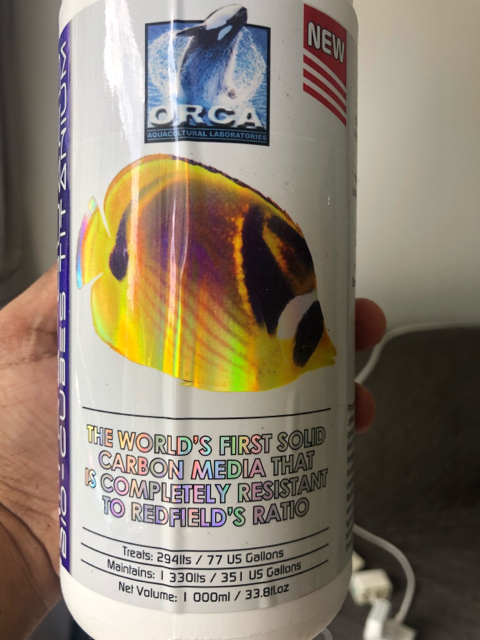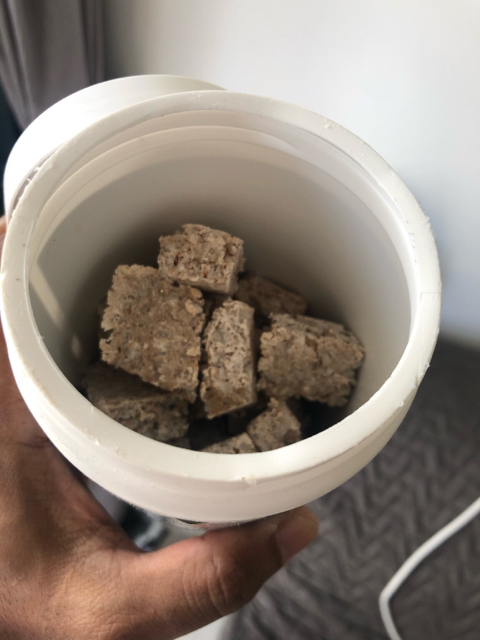
peedeers
-
Posts
510 -
Joined
-
Last visited
-
Days Won
1
Content Type
Profiles
Forums
Gallery
Posts posted by peedeers
-
-
This is thru my observation and testing in my aquarium. In every instance of cyano and dino occurance, my aquarium have low orp levels, likely indicating that organic levels in the aquarium is high. Taking measures to address these organics, for example thru the use of enzymes, or by increasing the amount of activated carbon, has significantly reduce these growth.
Same goes for brown algae, I observe the algae growth is more "brown" rather than "green" when the phosphate level is higher. And when the nitrate level is elevated, I do see more green algae.
So these are my observations. Not conclusive of course, but I think it's something worth considering
Okay want clear that it was just based your own ancedotal observation. If you looked at orp, you could also argue that maybr dinos/cyano causes reduced oxygen levels . In my case I have not seen that happening though. Activated carbon has had no impact on cyanos or dinos.
Also aside from just correllation how would you explain organics causing dinos?
Sent from Singapore Reef Club mobile app -
Algae and Nutrients
In the previous post, I discussed how reducing nutrients is not the key to algae management. But if we over-generalize and think that nutrients management is not important for algae control, then we can't be further from the truth.
In order to apply grazing pressure on algae, we need to introduce herbivores. But if these herbivores do not graze on the algal growth, then all is for naught. We reefers know well enough that fishes do have a preferences, as well as avoidance for centain food. Therefore, getting the aquarium to grow predominantly the correct type of algae, is the key to herbivorous control.
An example is the venerable yellow tang. Yellow tangs readily graze on green hair algae. It use the spade like teeth to cut the algae as it feed. However, if an aquarium has a sudden disruption, and has an outbreak of cyanobacteria, we can observe something interesting. When cyanobacteria covers the green hair algae, it's no longer palatable to yellow tangs, and the grazing stops.
The Algae Bender
Therefore to keep a pristine aquarium, the aquarist need only to manipulate the algal population in the aquarium, so that one or two species is dominant, then ensure there is the corresponding herbivores to keep these algae in check.
So how do we manipulation algae population? It's not as if we go around buying hair algae and bryopsis to throw inside the aquarium.
We do that by managing the nutrients. Nitrate and phosphate, in their organic and inorganic forms. Different nutrient level gives advantage to different algae. Generally speaking, higher organics contents gives rise to more bacteria-like algae such as cyano and dino; higher phosphate tends to courage growth of brown algae.
At the end of the day, manage the nutrient, manage the algae.
This is not true. Where did you get the info that highrt organics trigger dinos, cyano and inorganics trigger brown algae?
Sent from Singapore Reef Club mobile app -
Nopox is useless without a skimmer. Unless you do very large water changes.
Sent from Singapore Reef Club mobile app-
 1
1
-
-
-
-
-
-
-
This is Reserved until Sat
Sent from Singapore Reef Club mobile app -
-
-
Peedeers, Design 3,L,1
Sent from Singapore Reef Club mobile app -
-
Selling unopened box of Original tropic marin balling components a,b,c powders.
Pm if interested. Collection in pasir ris. Price 45 sgd.
Sent from Singapore Reef Club mobile app
-
Selling almost full Orca nitra guard titanium. No reactor required. Will reduce your nitrates without any dependency on Phospates.
Sold as the only solid carbon media that is completely resistant to the redfield ratio.
Definitely worked for me in reducing nitrates.
The media should last you for more than a year with continous usage.
Selling at 45 Sgd. pm if interested. Collection in pasirris.
Sent from Singapore Reef Club mobile app
-
Selling Dr. Tims NP active pearls bio-pellets.
Great polymer for reducing your nitrates.
Almost full. Selling for 70 Sgd.
PM if interested. Collection in pasirris.
Sent from Singapore Reef Club mobile app
-
To add on, i have always wondered why ocean water nitrate and phosphate levels are near undetectable and yet LPS thrive, so this makes me wonder why do we say LPS need higher nutrient levels?
Sent from Singapore Reef Club mobile app
It is always about availability rather than residual levels. In the ocean nutrient availability levels are high - even if residual levels show low. Also depending on currents sometimes residual levels also can become high.
Also, regarding sps needing low nutrients may not be very true. There are studies/ ancedotal evidence that shows sps growth is higher in higher phospate levels. What sps dont like is instability. So if you go from high phospates for some time to low phospates then that negatively impacts them. Same thing from low to high but to a lesser extent.
Interesting discussion though.
Sent from Singapore Reef Club mobile app -
You are right fish based proteins are better but more expensive. Plant/animal based proteins are usually deficient but cheaper thus being used.
It also depends on what amino acids are available in the proteins. Some like methionine are supposedly more useful than others. Also whats interesting is how proteins are used for growth. When carbs/lipids sufficiently provide energy, then proteins are used for growth. When lipids do not provide for the energy requirements, then proteins are actually used for energy thereby stunting growth. A balance is important.
Some studies on Aminos
https://www.researchgate.net/publication/288663939_Functional_amino_acids_in_fish_nutrition_health_and_welfare
https://www.sciencedirect.com/science/article/pii/S0044848614001690
Sent from Singapore Reef Club mobile app -
Feeding the Aquarium
The top of the line water processing facilities will do little to clean up the rivers if the factories and farms dumps chemicals indiscriminately. It's much cheaper for a country to control these polluters compared to trying to undo the damage.
Same logic goes for reef aquarium. It is easier and cheaper to ensure less pollution enter the aquarium, than to try to extract the pollution from the water.
That's why, I believe limiting the pollution is the first step towards health reef environment. However, it is crucial to note, that nutrient and pollution are not one and the same. One can feed the aquarium a lot, and cause very little pollution; while someone else may be heavily polluting the aquarium with minimum feeding. It all depends on how the feeding is done.
Who Needs Food in the Aquarium?
I would like to categorize the feeding clients into 3 categories:
1. Those who chases down the food, such as fishes and invertebrates
2. Those who wait for food to come to them, such as coral and sponges
3. Those who don't really "eat" such as bacteria and algae
In an properly cycled and matures system. The population of three groups don't fluctuate much. Therefore the feeding need is always there.
The Chaser
Fishes and some invertebrate goes after the food and extract them from water column. Their feeding is efficient, since they don't need the whole water volume to be flooded with food. In fact when some pellets are added into the feeding tube, the pellets are often wiped out before they drift very far. Feeding for this group is, by nature, rather targeted. It's also easily to evaluate how much food is consumed.
If the food is left unconsumed, it starts to decompose under the effect of bacteria action. This process consums oxygen, release carbon dioxid and lowers pH. It also release nitrogenous and phosphourus compounds. A source of pollution.
What's unseen is even more crucial. If a fish consume the whole pellet in one swallow. Does it mean none of the nutrient is leaked to the water?
Currently I'm using NewLife Spectrum pellets and TDO Chroma Boost. Recently, I came across Fauna Marin pellets. Interestingly, there is no terrestrial orgin ingredients in the food. I expect this food to be highly digestable. As the result, I expect the impact on free nutrient in the reef is minimal.
I doubled my feeding amount, with the addition being the Fauna Marin Pellets. Just like how I predicted, there is no visible impact on the phosphate and nitrate concentration.
Bro, good write-up but needs clarifying. You are right about binders not adding too much nutritional value , but not about adding nutrients to the water.
Binders used in pellets are carbohydrates ( starch, sugar etc). Some of it can be metabolized by fish for energy. But you dont end up with nitrates and phopates due to thhesr binders.
Nitrates from food usually comes from the protein content. About 65-70 percent of the protein in the food gets passed through the gills as Ammonia ( more than 50 percent) and in poop ( about 10 percent). This ammonia then breaks down into nitrates.
Choose the food that offers the most nutritional value. But the best foods does not automatically translate into the least nitrates/phospates.
Happy reefing !!
Sent from Singapore Reef Club mobile app-
 1
1
-
-
Bump
Sent from Singapore Reef Club mobile app -
Looking for a decent condition calcium reactor preferably dual chamber. Please PM if you are selling. Thanks
Sent from Singapore Reef Club mobile app
-
[mention=27152]peedeers[/mention]
ahh i see okay will try that. Thanks for the input!
My main concern about maintaining dKH levels with water changes is that I will only be able to replenish the levels once a week, and might result in drops and spikes, and would much prefer the stable approach of daily dosing. I also do not have the extra time to do mid week water changes as well
Will 1.025 be on the dangerous side however? My tank experiences fluctuations every day as I dont have an ATO, I'm afraid the heightened salinity to 1.027 at max will have adverse effects on the microfauna in my tank.
How about dosing, what are u currently dosing/ do u have any suggestions? Also do u think 8.5dKH is a good number to aim for, or to go for NSW levels at 7dKH?
At this point you are speculating that your tank needs any alk addition. You need to measure alk levels from a baseline to check actual usage. Then you can decide if u need to dose. And its usually better to keep your alk close to what your new salt mix is at - which is why I was saying to test your mix. Any level between 7 and 9 is just as good.
I would get an ATO asap. Stability is key - not whether you are at 1.025 or 1.021.
Sent from Singapore Reef Club mobile app -
i do 10% every week, and measuring with red sea pro test kit!
Okay start by checking the alk levels on the fresh mix. Your salinity must be low which is why the Alk is low. You can bring up Alk just by mixing it to 1.025 or 1.026.
Sent from Singapore Reef Club mobile app -
How frequently do you do water changes? If you are using red sea blue bucket your Alk should be much higher with only water changes given your stock levels. And what are you using to measure Alk?
Sent from Singapore Reef Club mobile app





Acropolis
in Members Tank & Specs
Posted
You said dinos and cyanos decreased your ORP levels earlier ?
Heres a study that phosphates enhance the growth of toxic dinos
https://res.mdpi.com/d_attachment/sustainability/sustainability-12-04992/article_deploy/sustainability-12-04992.pdf
Heres a study that shows uptake of organic and inorganic N on Ostreopsis- the kind that we usually deal with in our tanks
https://www.researchgate.net/publication/316157113_Uptake_of_dissolved_inorganic_and_organic_nitrogen_by_the_benthic_toxic_dinoflagellate_Ostreopsis_cf_ovata
Sent from Singapore Reef Club mobile app